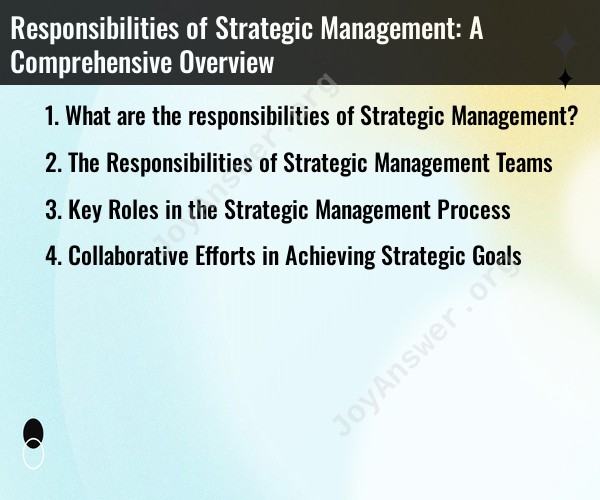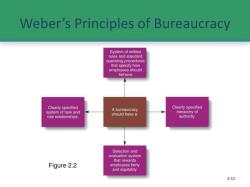What are the responsibilities of Strategic Management?
Strategic management is the process of formulating, implementing, and evaluating an organization's strategies to achieve its long-term goals and objectives. It involves various responsibilities that guide the organization's direction and success. The responsibilities of strategic management typically include the following:
Setting the Organizational Mission and Vision:
- Define the organization's mission, which outlines its core purpose and reason for existence.
- Develop a vision that describes the organization's desired future state and long-term goals.
Environmental Analysis:
- Assess the internal and external environment to identify strengths, weaknesses, opportunities, and threats (SWOT analysis).
- Monitor industry trends, market dynamics, and competitive forces.
Goal Setting:
- Establish clear and measurable strategic objectives that align with the mission and vision.
- Ensure that goals are specific, achievable, relevant, and time-bound (SMART).
Strategy Formulation:
- Develop strategies that outline how the organization will achieve its goals.
- Consider different approaches, such as cost leadership, differentiation, focus, or diversification, based on the organization's competitive advantage.
Strategy Implementation:
- Allocate resources, including people, funds, and technology, to execute the chosen strategies.
- Assign roles and responsibilities to individuals or teams.
- Develop detailed action plans, budgets, and timelines.
Organizational Alignment:
- Ensure that the organizational structure, culture, and processes are aligned with the selected strategies.
- Communicate the strategy throughout the organization to gain buy-in and commitment.
Monitoring and Control:
- Establish key performance indicators (KPIs) to track progress and success.
- Continuously monitor and assess the performance of the strategies.
- Implement corrective actions when necessary to stay on course.
Strategic Change Management:
- Adapt strategies as needed in response to changing internal or external conditions.
- Handle resistance to change and facilitate smooth transitions.
Risk Management:
- Identify and assess potential risks and uncertainties that may affect the achievement of strategic objectives.
- Develop risk mitigation strategies and contingency plans.
Innovation and Learning:
- Foster a culture of innovation and continuous learning within the organization.
- Encourage employees to generate new ideas and improve existing processes.
Competitive Analysis:
- Monitor competitors and industry trends to identify opportunities for differentiation and staying ahead in the market.
Stakeholder Engagement:
- Engage with various stakeholders, including customers, employees, shareholders, and communities, to understand their needs and concerns.
- Ensure that strategies consider the interests of all stakeholders.
Resource Allocation:
- Make decisions regarding the allocation of financial and non-financial resources based on the priorities set by the strategies.
Ethical and Social Responsibility:
- Ensure that the organization's strategies and actions align with ethical principles and social responsibilities.
- Address environmental and social concerns when formulating strategies.
Performance Evaluation:
- Regularly evaluate the effectiveness of the strategies in achieving the organization's long-term objectives.
- Use performance data to make informed decisions and refine strategies.
Communication and Reporting:
- Keep stakeholders informed about the organization's strategic progress through regular reporting and communication.
Long-term Planning:
- Develop long-term plans that guide the organization's strategic direction and investment in future growth.
Strategic management is an ongoing process that requires adaptability and flexibility in response to changing circumstances. The responsibilities of strategic management are integral to ensuring an organization's sustainability, growth, and success in an ever-evolving business landscape.
The Responsibilities of Strategic Management Teams
Strategic management teams (SMTs) are responsible for developing and implementing an organization's strategy. They typically consist of senior executives from different departments within the organization, such as finance, marketing, and operations.
The responsibilities of SMTs include:
- Developing a strategic vision and mission: The SMT works with the board of directors to develop a strategic vision and mission for the organization. This includes identifying the organization's long-term goals and objectives.
- Analyzing the environment: The SMT analyzes the organization's external and internal environment to identify opportunities and threats. This includes assessing the competitive landscape, customer trends, and technological advancements.
- Formulating a strategy: The SMT uses the information from the environmental analysis to formulate a strategy for achieving the organization's goals. This includes developing strategies for competing in the market, developing new products and services, and expanding into new markets.
- Implementing the strategy: The SMT is responsible for implementing the strategy that has been formulated. This includes allocating resources, developing action plans, and monitoring progress.
- Evaluating the strategy: The SMT regularly evaluates the strategy to ensure that it is still aligned with the organization's goals and that it is effective in achieving those goals.
Key Roles in the Strategic Management Process
There are a few key roles that are typically involved in the strategic management process:
- CEO: The CEO is the overall leader of the organization and is responsible for setting the strategic direction of the company.
- Board of directors: The board of directors is responsible for overseeing the management of the organization and for ensuring that the SMT is accountable for its performance.
- SMT: The SMT is responsible for developing and implementing the organization's strategy.
- Department heads: Department heads are responsible for executing the strategy within their respective departments.
- Employees: Employees play a vital role in the strategic management process by implementing the strategy and providing feedback to the SMT.
Collaborative Efforts in Achieving Strategic Goals
Achieving strategic goals requires a collaborative effort from all members of the organization. The SMT must work closely with the board of directors, department heads, and employees to ensure that everyone is aligned with the organization's goals and objectives.
Here are some ways to promote collaboration in the strategic management process:
- Involve all stakeholders in the strategic planning process. This will help to ensure that everyone is invested in the success of the strategy.
- Create a culture of open communication and feedback. This will encourage everyone to share their ideas and concerns.
- Empower employees to make decisions and take risks. This will help to foster a sense of ownership and engagement in the strategic management process.
- Celebrate successes and learn from failures. This will help to maintain a positive and productive atmosphere.
By collaborating effectively, organizations can increase their chances of achieving their strategic goals.












